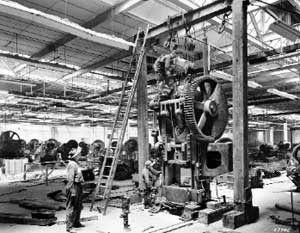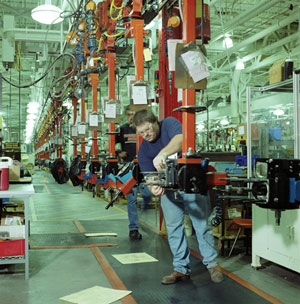NORTH AMERICAN REPORTS
Hog Heaven
| B |
elieve it or not, in the early days of Harley- Davidson's now 105- year tenure in Milwaukee, the company sought to be known for how quietly its motorcycles purred.
In the fall of 2006 its global economic roar
 |
| Harley- Davidson's longstanding union ties are as solid as the machinery those workers employ. Photo: Harley- Davidson Archives; Copyright H- D |
 |
Two weeks later, that plan had evolved into a bigger plan: $300 million invested in Wisconsin operations over the next several years. In exchange the company received an incentive of $4.5 million in enterprise zone tax credits.
"A few weeks ago, many thought these additional jobs were heading out of Wisconsin, but the company, the union, and my administration never gave up," Governor Jim Doyle said on Dec. 1.
"The site selection process, above all, was about Harley- Davidson's need to expand air- cooled V- Twin powertrain capacity and do so in a way that reduces long- term costs and improves manufacturing flexibility," Harley- Davidson spokesman Bob Klein tells Site Selection. "Our initial concept was to build a new plant in a new location in some other part of the U.S. as the most efficient path to achieving our capacity, cost and flexibility goals. We envisioned a process similar to that which led to the building of our Kansas City plant in the mid- 1990s. In that case, the international unions were involved in the site selection and in structuring the operations."
But hometown union leaders asked whether there might still be a way to achieve those cost and flexibility goals in Milwaukee, says Klein, which led to the proposal that took two votes to pass. Everything gets put back on the negotiating table in 2012, but "now we can look forward to expanding here, rather than worry about a rival plant that would produce the same product with newer, state of the art equipment," said Jim Wheiland, local USW president. The company did not disclose the multiple sites under consideration.
The concessions came after the company had reported 2005 earnings of nearly $1 billion, though some saw this as a too- facile reading of a financial statement. While pensions for current workers remain undisturbed, there are new arrangements in the memorandum of understanding:
• The lowest starting wage rate for new hires will be $18.25 an hour for power train production jobs, but the union- negotiated training program will encourage workers to move up into machine operator positions that will pay $24.42 an hour. Current employees in those positions will continue to earn $28.83 an hour.
• COLA payments will be suspended until 2012 for all employees, and the new hires will not be eligible to participate in the contributory annuity that is administered by the company.
• A new cost- sharing health care package will cover new hires on Jan. 1, 2007, and cover all employees on July 1, 2008.
The concessions send multiple messages: to the pending union/company negotiations with the International Association of Machinists and Aerospace Workers (IAMAW) in Milwaukee and to upcoming USW and IAMAW negotiations in Kansas City and York, Pa.; and to other companies looking for signs of flexibility in staunch union territory.
"On one hand I never want to celebrate the reduction in anyone's wages, and in fact, what this agreement has done is reduce the wage for work being done at Harley- Davidson," says Tim Sheehy, president of the Metropolitan Milwaukee Association of Commerce (MMAC). On the other hand, the region has to position itself as a viable platform for companies to compete in the global marketplace, he says. "What makes Milwaukee un- flat in a flat world?" asks Sheehy. "This is a stark reminder that both companies and the work force have got to continuously figure out how we integrate and upgrade our skill sets if we are going to command high- wage jobs."

